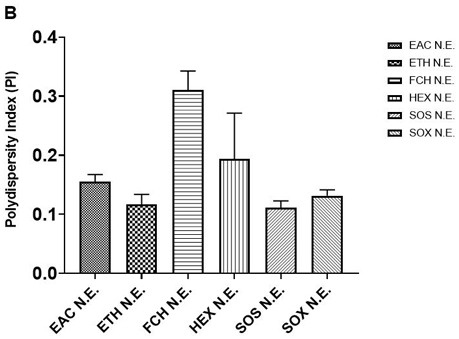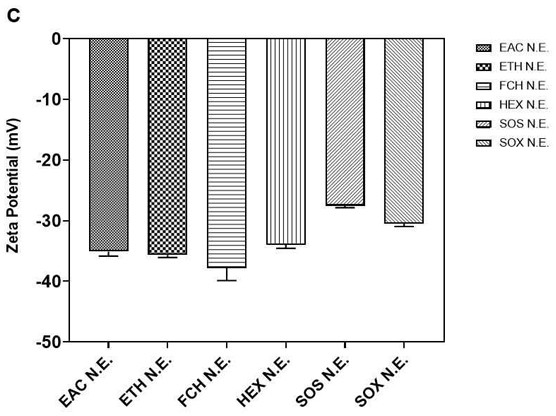Lipid nanoemulsion with effect of removing reactive oxygen free radicals in cells, and preparation method thereof
A lipid nanotechnology, cell removal technology, applied in food ingredients as emulsifier, application, food homogenization and other directions, can solve problems such as single chemical substances, achieve controllable particle size, good physical and chemical stability, and biological safety. significant effect
- Summary
- Abstract
- Description
- Claims
- Application Information
AI Technical Summary
Problems solved by technology
Method used
Image
Examples
Embodiment 1
[0034] The preparation method of embodiment 1 sea urchin yellow lipid nanoemulsion
[0035] (1) Preparation of sea urchin yellow lipid
[0036] 1. Pretreatment
[0037] Open the sea urchin shell, take out the sea urchin yellow, rinse with 1% salt water, drain the water, and vacuum freeze-dry.
[0038] 2. Ultrasonic-assisted organic solvent extraction
[0039] (1) Ethyl acetate system (EAC) is used. The ratio of solid to liquid is 1:20 (w / v, g / mL), protected from light, 25°C, ultrasonic frequency 100Hz, ultrasonic for 30 min, and the temperature of the water bath is adjusted to 25°C every 10 minutes. Stir at room temperature for 20 minutes, centrifuge, filter the extract through a membrane, protect from light, concentrate under reduced pressure at 35°C under nitrogen flow, and dry to constant weight. The yield is 20.6%.
[0040] (2) Ethanol system (ETH) is used. The ratio of solid to liquid is 1:20 (w / v, g / mL), protected from light, 25 °C, ultrasonic frequency 100 Hz, ultras...
Embodiment 2
[0055] The preparation method of embodiment 2 sea urchin yellow lipid alcohol extract
[0056] Select ethanol as the extractant, and its extract is oil alcohol extract, and the specific steps are as follows:
[0057] Weigh 4.0 g of sea urchin yellow lipid prepared in different solvent systems into a glass centrifuge tube, add 5 mL of absolute ethanol, vortex and shake at room temperature for 5 min in the dark, and centrifuge, transfer the upper alcohol extract to a brown glass sample bottle , repeated the extraction 3 times, and combined the upper ethanol extracts to obtain 0.2 g / mL echinacea lipid alcohol extract.
Embodiment 3
[0058] Example 3 Cell proliferation-toxicity evaluation
[0059] The human liver cancer cell line HepG-2 was used to evaluate the cell proliferation-toxicity of quercetin, echinacein lipid alcohol extract, emulsion and nanoemulsion. Quercetin was used as the standard antioxidant compound and quercetin was dissolved using DMSO. Quercetin, echinacea lipid alcohol extract, echinacea lipid emulsion and echinacea lipid nanoemulsion were diluted with MEM-α basal medium containing 1% antibacterial-antifungal agent.
[0060] Use MEM-α complete medium containing 10% fetal bovine serum and 1% antibacterial-antifungal agent at a final concentration of 37°C in 5% CO 2 Culture HepG-2 cells. HepG-2 cells were divided into 1×10 5 cells / mL, 100 μL / well, were inoculated into a transparent bottom 96-well plate, with 6 parallel wells in each group, and cultured for 24 h adherently. The original medium was discarded, and 100 μL / well of the diluted sample (experimental group) and MEM-α basal m...
PUM
 Login to View More
Login to View More Abstract
Description
Claims
Application Information
 Login to View More
Login to View More - R&D
- Intellectual Property
- Life Sciences
- Materials
- Tech Scout
- Unparalleled Data Quality
- Higher Quality Content
- 60% Fewer Hallucinations
Browse by: Latest US Patents, China's latest patents, Technical Efficacy Thesaurus, Application Domain, Technology Topic, Popular Technical Reports.
© 2025 PatSnap. All rights reserved.Legal|Privacy policy|Modern Slavery Act Transparency Statement|Sitemap|About US| Contact US: help@patsnap.com



